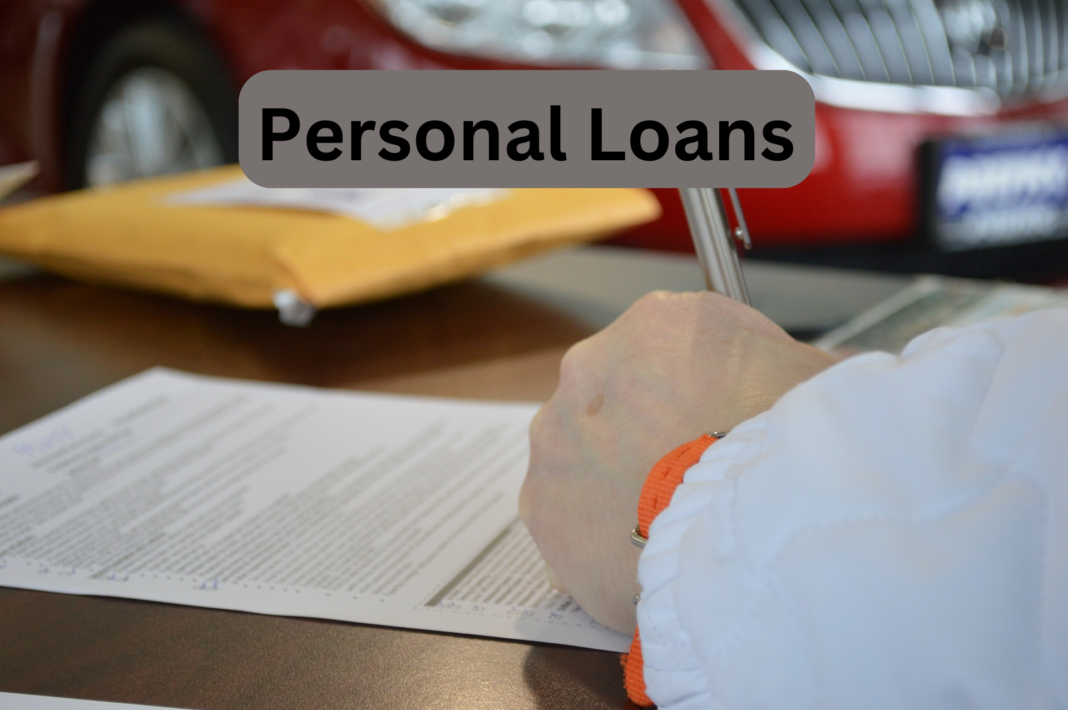Not everyone qualifies for a loan on their own when it involves borrowing money; sometimes, credit score or financial history gets in the way. That is where cosigned personal loans come in. Such loans can be a lifesaver for individuals needing financing that may not otherwise qualify for education, debt consolidation, or other personal reasons. But what exactly are cosigned personal loans, and how do they work?

This comprehensive guide reveals the inner details of how cosigned personal loans work. We outline everything from how these kinds of loans work to the benefits and risks for borrowers and cosigners. Whether you are considering asking someone to cosign a loan for you or you’ve been asked to be a cosigner yourself, this article is intended to equip you with all that you need to know in order to make an informed decision.
Now we are going to discuss how one goes about applying, how cosigned loans can affect your credit scores, and ways in which you may manage this particular loan responsibly. By the time this article is done, you will have a certain idea of cosigned personal loans and whether they are apt for your situational needs.
What is a Cosigned Personal Loan?
A cosigned personal loan is one in which someone with a better credit profile accepts an equal responsibility to repay the amount owed. This third party is known as the cosigner.
Here’s what you need to know:
The cosigner also has equal liability of the loan and is obligated to pay it off when the primary borrower defaults.
-Loans with a cosigner usually offer better terms, such as lower interest rates, than the primary borrower would qualify for.
- The credit history of both the borrower and cosigner is factored into the loan application.
- The loan appears on the credit reports for both individuals.
Why People Use Cosigned Personal Loans
Here’s why someone might apply for a cosigned personal loan:
- Insufficient or bad credit history: The young adult or whoever having poor credit cannot be eligible on their own for loans.
- Lower interest rate: With a cosigner, one can get a good credit that allows access to better loan terms.
- Higher loan amount: Lenders may be willing to give out larger loans with a cosigner.
- Debt consolidation: Cosigned loans also facilitate the consolidation of high-interest debts into one single and more manageable payment.
How Cosigned Personal Loans Work
Both borrowers and potential cosigners must understand how cosigned personal loans work. Here is a step-by-step explanation of how these types of loans usually work:
Application Process
- Application by the Primary Borrower: The borrower in need applies.
- Cosigner’s Consent: A cosigner with good credits agrees to be the guarantor for the loan.
- Joint Application: The two parties provide their financial information to the lender.
- Credit check: The lender investigates the credit history of both parties.
- Approval and terms: Upon approval, the lender determines the loan terms according to the combined financial profile.
- Signing: The original borrower and the cosigner sign the loan agreement.
Repayment Responsibility
While the primary borrower is supposed to make the repayments, from the lender’s perspective, both parties are liable. For example, if the primary borrower defaults on the payments, the lender can turn to the cosigner for collection.
Benefits of Cosigned Personal Loans
Cosigned personal loans offer advantages to borrowers who might not have gotten financing otherwise. Let us look at those advantages in depth:
For the Primary Borrower
You may have greater access to credit by the party with a poor credit history. A cosigner might also permit you to get better loan terms, like having a lower interest rate and/or superior repayment terms. The lenders might allow you to borrow more money.
- Opportunity to build credit: The primary borrower can have credit established or improved if payments are made in a timely manner on the cosigned loan.
- Debt consolidation: Cosigned loans can be used to consolidate debt, potentially allowing borrowers to save money on interest throughout the life of the loan.
For the Cosigner
While not as prevalent, there are a few potential cosigner benefits:
- Supporting a Family Member or Friend: The cosigning of a loan may be a good way to help a loved one achieve his or her financial goals.
- Potential Credit Score Boost: If the loan is handled responsibly, it can potentially boost your credit score.
- No Upfront Costs: Unlike gifting money, cosigning does not require any immediate financial outlay.
Risks and Considerations for Cosigned Personal Loans
While cosigned personal loans have a lot of benefits, they come with substantial risks and considerations that both parties in the transaction should consider thoughtfully:
Risks to the Primary Borrower
- Potential for relationship stress: Financial issues may arise between the borrower and the cosigner.
- Shared credit report impact: Delinquency or default will negatively affect both parties’ credit scores.
- Reduced future borrowing ability: The cosigned loan will be included in the borrower’s debt-to-income ratio, possibly impacting their future loan ability.
Cosigner Risks
Risks for the cosigner are very high:
- Full financial responsibility: If the primary borrower defaults, the cosigner is liable for the full amount of the loan.
- Credit score damage: Delinquent payments or defaults will damage the cosigner’s credit score, even if they weren’t responsible for the payments.
- Reduced borrowing capacity: The loan being cosigned will appear on the cosigner’s credit report, which may limit their ability to get their own loans later.
- Removing a cosigner is problematic: Once signed, it is generally very hard to remove a cosigner from a loan.
- Legal action possible: In case of defaults, a lender can take a lawsuit on the cosigner against him for the repayment of loans.
Alternatives to Cosigned Personal Loans
Before taking the option of cosigned personal loans, options around it should be scanned:
- Secured personal loans: Offering collateral, such as a car or savings account, may help qualify someone without a cosigner.
- Credit-builder loans: These are special loans designed for building credit.
- Peer-to-peer borrowing: The need for an excellent credit score can be relaxed in certain online sites, and it hence might accommodate borrowers with less than a perfect credit history.
- Pread Approve Your Credit: The better the credit score, the better your chances of getting approved for a loan in your name.
- Borrowing from Family or Friends: Though it involves risks, it is a better option than a formal cosigned loan for some.
- Searching for government or non-profit programs: Depending on your circumstances, you may discover some support programs.
How to Get a Cosigned Personal Loan
Have you decided it is the right move to get a cosigned personal loan? The following are steps you’ll want to take to get one:
- Monitor your credit: Find out your current credit score so you will know if you need a cosigner.
- Get a cosigner: Request a person in your inner circle with good credit to cosign.
- Be open: Explain to your potential cosigner the terms of the loan, the risks, and a plan for repayment.
- Shopping: Get around to get better rates and terms from different lenders
- Preparing proper documentation: you and your cosigner must disclose your financial information.
- Apply together: Apply together with the cosigner.
- Understand the agreement fully: If the loan agreement is approved, ensure you and your cosigner fully comprehend all its aspects before sealing your signature.
Managing a Cosigned Personal Loan: Tips
Managing a personal loan with a cosigner responsibly helps protect the financial wellness of both the borrower and the cosigner. Here are some tips for managing a personal loan with a cosigner.
For the Primary Borrower
- Create a budget: Ensure the loan payments go comfortably within your month-on-month budget.
- Set up automatic payments: This way, you will not miss or pay late.
- Communicate with your cosigner: Keep them informed about the loan status, especially in cases where you may experience payment difficulties.
- Consider life insurance: It will protect your cosigner if something happens to you.
- Work towards release: Some lenders offer cosigner release after a certain number of on-time payments. If possible, work towards this.
For the Cosigner
- Keep an eye on the loan. Track the payments to ensure they are sent on time.
- Request alerts from the lender: Ask the lender to notify them of any late or missed payments.
- **Maintain open communication: The cosigner should be in constant contact with the primary borrower concerning their financial situation.
- Know your rights: Understand what you can legally and financially do as a co-signer.
- Hope for the best, but prepare for the worst: Have a plan should you need to take on the payments.
Impact on Credit Scores
Cosigned personal loans can have significant influences on the credit scores of both the primary borrower and cosigner alike:
For the Primary Borrower
- Positive impact: Timely payments positively help to build or improve credit scores.
ImprovementNegatif impact: Late payment or defaults will harm credit scores.
New credit inquiry: The credit score will be slightly reduced, short-term, at the time of initial application.
Credit mix: An installment loan will positively impact your credit mix.
For the Cosigner
Potential positive impact: If the loan is well-managed, the cosigner’s credit score will improve.
- Risk of adverse impression: Any late payments and defaults will hurt the cosigner’s credit score.
- Increased credit utilization: The loan will be taken into account in the cosigner’s overall debt, which can potentially impact the credit utilization ratio.
Legal Considerations of Cosigned Personal Loans
By far, a very important consideration by both parties must involve the legalities of cosigned loans:
- Joint liability: The legal world puts them on par in terms of the said debt.
- Collections and Lawsuits: In case of loan default, the lender can start collections or even take legal action against either party to effectuate repayment.
- Bankruptcy Considerations: If the primary borrower files for bankruptcy, the cosigner may also be liable for the loan.
- Statute of Limitations: Understand the statute of limitations for collecting debt in your state.
- Cosigner rights: A handful of states enact unique protection for cosigners, such as notifying them when payments are in arrears.
When to Consider Removing a Cosigner
Under specific circumstances, it will make sense to remove a cosigner from a loan:
- Better credit: If the primary borrower’s credit has improved significantly, they may be in a position where they can refinance alone.
- Changed relationship: If the relationship between the borrower and the cosigner sours, it may be prudent to separate finances.
- Changes to the cosigner’s finances: Changes to the cosigner’s finances may be a reason for them to request release from the obligation.
How to Remove a Cosigner
- Verify lender policies: Many lenders have a policy that allows cosigner release with a certain number of on-time payments.
- Refinance: The primary borrower may be able to get a new loan in their name alone, which would pay off the cosigned loan.
- Payoff of loan: The easiest way to release the cosigner is to pay off the loan in full.
Conclusion
A cosigned personal loan is a very powerful financial tool. It extends credit to otherwise unqualified people, probably on terms more favorable than they might have received on their own. Yet, the financial responsibilities and perils involved are immense for both the primary borrower and the cosigner.
Before entering into a cosigned loan agreement, both parties should know the terms involved, risks possible, and probable results of such a situation. Open communication, careful financial planning, and a well-thought-out repayment strategy are the general keys to success in handling the cosigned personal loan.
Remember that cosigned loans can be a godsend, but they are not to be taken lightly. The borrower must carefully consider the cosigner and their financial situation to see if there are any alternatives while being prepared for all possible outcomes.
Ultimately, cosigned personal loans taken responsibly may be a stepping stone to financial goals and improved credit. They require trust, commitment, and fiscal responsibility on the part of both parties. With insight into cosigned loans and best management practices, borrowers and cosigners can use this financial arrangement to strengthen finances and relationships.






